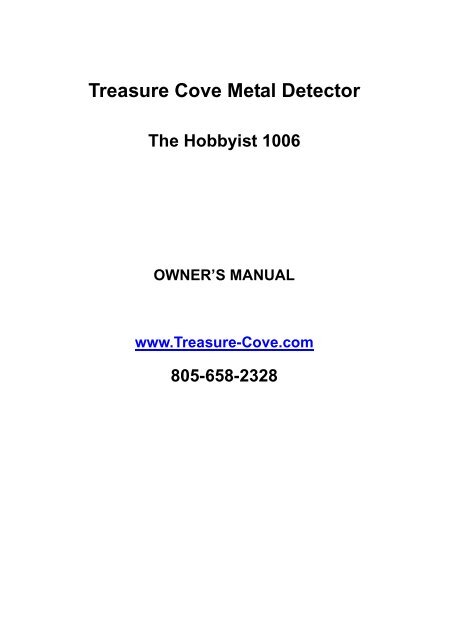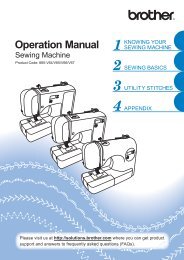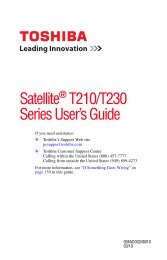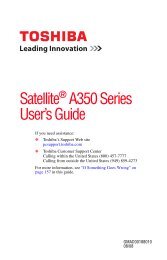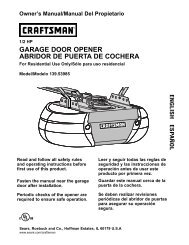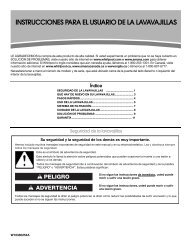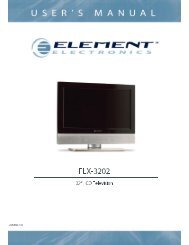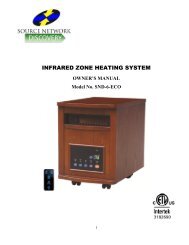Treasure Cove Hobbyist Model 1006 Manual
Treasure Cove Hobbyist Model 1006 Manual
Treasure Cove Hobbyist Model 1006 Manual
Create successful ePaper yourself
Turn your PDF publications into a flip-book with our unique Google optimized e-Paper software.
<strong>Treasure</strong> <strong>Cove</strong> Metal Detector<br />
The <strong>Hobbyist</strong> <strong>1006</strong><br />
OWNER’S MANUAL<br />
www.<strong>Treasure</strong>-<strong>Cove</strong>.com<br />
805-658-2328
FEATURE<br />
With your metal detector, you can hunt for coins, relics, jewelry, gold, and<br />
silver just about anywhere. The detector is versatile and easy to use.<br />
The detector’s features include:<br />
Headphone Jack—let you connect headphones (not supplied) and<br />
operate without trouble.<br />
View Meter and Pointer—shows the probable type of metal being<br />
detected .<br />
Waterproof Search Coil—Can be used in shallow water.<br />
Note: The search coil is waterproof, but the control housing is not<br />
waterproof.<br />
Adjustable stem—let you adjust the detector’s length for comfortable<br />
use.<br />
Power—1x 9V DC battery(not supplied)<br />
PREPARATION<br />
1. INSTALLING THE DETECTOR<br />
the installation can be finished easily without tools, just following the steps<br />
in below:<br />
Turn the stem’s lock nut clockwise until it loosens.<br />
Lengthen or shorten the stem so when you stand upright with the<br />
detector in your hand, the search coil is level with and about 1.3-5cm<br />
above the ground with your arm relaxed at your side.<br />
2
Then turn the stem’s lock nut counter clockwise to lock it in place.<br />
Note:<br />
No need to loosen the stem lock completely, or the plastic ring inside may<br />
easily fall out and got lost. If the inside ring falls out, please put it back<br />
and then tighten the lock set.<br />
Loosen the knobs at the search coil’s end, then adjust the search coil<br />
to the desired angle. (The search coil should be parallel with the<br />
ground.) Tighten the knobs just enough to keep the search coil from<br />
rotating or wobbling.<br />
2. INSTALLING BATTERIES<br />
Power off the detector.<br />
3
Slide the battery cover off in the direction of the arrow.<br />
Insert the battery into the compartment as indicated by the polarity<br />
symbols (+ and -) marked inside the compartment. And then replace<br />
the cover.<br />
Cautions:<br />
Always remove old or weak batteries, which can leak chemicals that<br />
can destroy electronic parts.<br />
If you do not plan to use the detector for a week or more, remove the<br />
batteries.<br />
Dispose the old batteries promptly and properly.<br />
Replace the battery when "LOW BATT" light turns on.<br />
3.USING HEADPHONE<br />
You can connect a pair of stereo headphones (not supplied) to the<br />
detector so you can listen to it privately. Using headphone also saves<br />
battery power and makes it easier to identify subtle changes in the<br />
sounds you hear, for better detection results.<br />
To connect headphone to the detector, insert the 3.5mm plug into the<br />
4
headphone jack on the side of the control housing. The detector’s<br />
internal speaker disconnects when you connect the headphone.<br />
Listening Safely<br />
Do not listen at extremely high volume levels. Extended high volume<br />
listening can lead to permanent hearing loss.<br />
Do not wear earphones while operating your detector near<br />
high-traffic areas<br />
OPERATION<br />
This Metal Detector distinguishes between ferrous and nonferrous metals.<br />
Ferrous metal includes iron, while non-ferrous metals such as gold, silver,<br />
copper, platinum, aluminum, lead, and zinc.<br />
1. POWER ON THE DETECTOR<br />
Hold the detector in a comfortable position, then rotate VOLUME away<br />
from OFF to power on the detector.<br />
2. TUNING<br />
Rotate VOLUME to the 11 o’clock position.<br />
Set DISC to its midpoint.<br />
Hold the search coil about 1 feet away from the ground, hold down<br />
the red button on the handle, and slowly rotate TUNE left and right<br />
until the pointer on the view meter rests at or near 0, then release<br />
the red button.<br />
5
Note:Press the red button on the handle at any time during operation<br />
and the pointer will return to 0 automatically.<br />
3.USING THE DETECTOR<br />
Remove watches, rings, or other metal jewelry you are wearing<br />
Holding the search coil level and about 1/2-2 inches above the<br />
ground.<br />
Slowly move the search coil over the area where you placed the<br />
sample, sweeping the search coil in a side-to-side motion. The<br />
distance of the movement path should be around 10~15cm. The<br />
smaller the target metal, the closer you should hold the detector to<br />
the ground.<br />
If the detector detects the material, it will give a sound indication.<br />
6
When detecting ferrous metal, detector will give out a lower voice and<br />
the pointer moves to the left. When detector finds non-ferrous metal,<br />
it will make louder voice while the pointer turns to the right.<br />
If the detector does not detect the material, check the battery power<br />
and check if the search coil is properly connected.<br />
Using DISC to enable the detector discriminate different metal.<br />
Caution:<br />
Every time after adjusting the DISC, the user needs to do the tuning<br />
again.<br />
TESTING AND USING THE DETECTOR<br />
To learn how the detector reacts to different metals, you should test it<br />
before you use it the first time. You can test the detector indoors and<br />
outdoors.<br />
1. INDOOR TESTING<br />
Remove any watches, rings, or other metal jewelry you are<br />
wearing, then place the detector on a wooden or plastic table.<br />
Adjust the search coil’s angle so the flat part faces the ceiling.<br />
Note: Never test the detector on a floor inside a building. Most<br />
buildings have metal of some kind in the floor, which might<br />
interfere with the objects you are testing or mask the signal<br />
completely.<br />
Rotate VOLUME to the 11 o’clock position. Set DISCRIMINATION to<br />
its midpoint. Press the red button, and slowly rotate left and right until<br />
7
the pointer on the view meter rests at or near 0.<br />
Move a sample of the material you want the detector to find (such<br />
as a gold ring or a coin) about 5 cm above the search coil. If the<br />
detector detects the material, the pointer moves to the left (ferrous)<br />
with its sound down or to the right (non-ferrous) with its sound up<br />
while the detector determines the type of meal it is detecting. If the<br />
detector does not detect the material, check the battery power and<br />
verify that the search coil is properly connected.<br />
Note: If you are using a coin, the detector detects it more easily if you<br />
hold it so a flat side is parallel with the flat side of the search coil (not<br />
the edge).<br />
2. OUTDOOR TESTING & USING<br />
Find an area on the ground outside where there is no metal.<br />
Place a sample of the material you want the detector to find (such as<br />
a gold ring or a coin) on the ground. (If you are using valuable metal<br />
such as gold to test the detector, mark the area where you<br />
placed the item, to help you find it later. Do not place it in tall grass or<br />
weeds.<br />
Rotate VOLUME about two-thirds clockwise. Set DISCRIMINATION<br />
to its midpoint.<br />
Press the red button, and slowly rotate left and right until the pointer<br />
on the view meter rests at or near 0.<br />
While holding the search coil level and about 2.5-5 cm above the<br />
ground, slowly move the search coil over the area where you placed<br />
8
the sample, sweeping the search coil in a side-to-side motion.<br />
Before try finding other metal in the area, press the red button to<br />
return the pointer to the center of the view meter.<br />
Search Coil Sweeping Hints:<br />
Never sweep the search coil as if it were a pendulum. Raising the<br />
search coil while sweeping or at the end of a sweep causes false<br />
readings.<br />
Sweep slowly – hurrying makes you miss targets.<br />
If the detector detects the material, it sounds a tone and the pointer<br />
moves to the type of metal it found.<br />
If the detector does not detect the material, make sure you are moving<br />
the search coil correctly.<br />
Notes:<br />
The detector responds with a strong signal when it detects most<br />
valuable metal objects. If a signal does not repeat after you sweep<br />
the search coil cover the target a few times, the target is probably<br />
junk metal.<br />
False signals can be caused by trashy ground, electrical interference,<br />
or large irregular pieces of junk metal. False signals are usually<br />
broken or non-repeatable.<br />
3. USEFUL SKILLS<br />
How to use DISC<br />
Discrimination is the detector’s ability to differentiate between types of<br />
9
metal. The detector’s DISCRIMINATION setting determines whether<br />
the detector will distinguish between different types of ferrous and<br />
non-ferrous metals.<br />
You can set DISCRIMINATION to minimum (fully counterclockwise),<br />
with rotating clockwise, the detector first discriminates iron, then pull<br />
tabs and nickel. When set the DISCRIMINATION fully clockwise,<br />
silver still cannot be discriminated. The sound will be lower and the<br />
pointer will move to left when the unit detects discriminated metal.<br />
The sound will be higher and the pointer will move to right when the<br />
unit detects metal, which is not discriminated.<br />
Note: Each time you use the detector in a different area, you must<br />
adjust DISCRIMINATION. Each search location presents new<br />
challenges.<br />
About false signals<br />
Because your detector is extremely sensitive, trash-induced signals<br />
and other sources of interference might cause signals that seem<br />
confusing. The key to handling these types of signals is to dig for only<br />
those targets that generate a strong, repeatable signal. As you sweep<br />
the search coil back and forth over the ground, learn to recognize the<br />
difference between signals that occur at random and signals that are<br />
stable and repeatable.<br />
The factors may affect detection<br />
No detector is 100 percent accurate. Various conditions influence<br />
metal detection. The detector’s reaction depends on a number of<br />
10
things: the angle at which the object rests in the ground, the depth of<br />
the object, the amount of iron in the object, the size of the object.<br />
4. PINPOINTING A TARGET<br />
Accurately pinpointing a target makes digging it up easier. However, it<br />
needs practice to improve this skill, and we suggest you practice finding<br />
and digging up small metal objects on your own property before you<br />
search other locations. Sometimes, targets are difficult to accurately<br />
locate due to the sweep direction. Try changing your sweep direction to<br />
pinpoint a target.<br />
Please follow these steps to pinpoint a target:<br />
When the detector detects a buried target, continue sweeping the<br />
search coil over the target in a narrowing side-to-side motion.<br />
Make a visual note of the exact spot on the ground where the<br />
detector beeps.<br />
Stop the search coil directly over this spot on the ground. Then<br />
move the search coil straight forward away from you and straight<br />
back toward you a couple of times.<br />
Make a visual note of the exact spot on the ground where the<br />
detector beeps.<br />
Repeat Steps 1-2 at a right angle to the original search line,<br />
making an “X” pattern. The target should be directly below the “X”<br />
at the point of the loudest response.<br />
11
Notes:<br />
If trash in an area is so heavy that you get false signals, slow your<br />
sweep speed and use shorter sweeps.<br />
Recently buried coins might not respond the same as coins buried<br />
for a long period of time because of oxidation.<br />
Some nails, nuts, bolts, and other iron objects (such as old bottle<br />
caps) oxidize and create a “halo” effect. A halo effect is caused by a<br />
mixture of natural elements in the ground and the oxidation created<br />
by different metals. Because of the metal mixtures, target signals<br />
might not be in a “fixed” position. This effect makes these objects<br />
very hard to detect accurately.<br />
TROUBLE SHOOTING<br />
If your detector is not working as it should, follow the suggestions below<br />
to see if you can eliminate the problem.<br />
Problem Suggestions<br />
The detector displays or<br />
sounds false signals.<br />
You might be sweeping the detector’s<br />
search coil too fast or at the wrong<br />
angle. Sweep the search coil more<br />
slowly and hold the detector correctly.<br />
See “Testing and Using the Detector”<br />
and “Pinpointing a Target”.<br />
12
The display does not show<br />
the correct metal type<br />
when the detector finds a<br />
target.<br />
CARE AND MAINTENANCE<br />
The detector might sound a false<br />
signal if it detects heavily oxidized<br />
metals. Try pinpointing the target from<br />
several different angles (see<br />
“Pinpointing a Target”). If the detector<br />
does not display and sound the same<br />
signal each time, the target is<br />
probably heavily oxidized metal.<br />
There might be more than one target<br />
in the area you are searching.<br />
The target might be a type of metal<br />
that the detector does not recognize.<br />
If the target is heavily oxidized, the<br />
detector might not display the correct<br />
metal type. This is not a malfunction.<br />
Your metal detector is an example of superior design and craftsmanship.<br />
The following suggestions will help you care for your metal detector so<br />
you can enjoy it for years.<br />
Handle the detector gently and carefully. Dropping it can damage<br />
circuit boards and cases and can cause the detector to work improperly.<br />
Use the detector only in normal temperature environments.<br />
13
Temperature extremes can shorten the life of electronic devices, damage<br />
the cases of the detector.<br />
Wipe the detector with a damp cloth occasionally to keep it<br />
looking new. Do not use harsh chemicals, cleaning solvents, or strong<br />
detergents to clean the detector.<br />
Keep the detector away from dust and dirt, which can cause<br />
premature wear of parts.<br />
14


